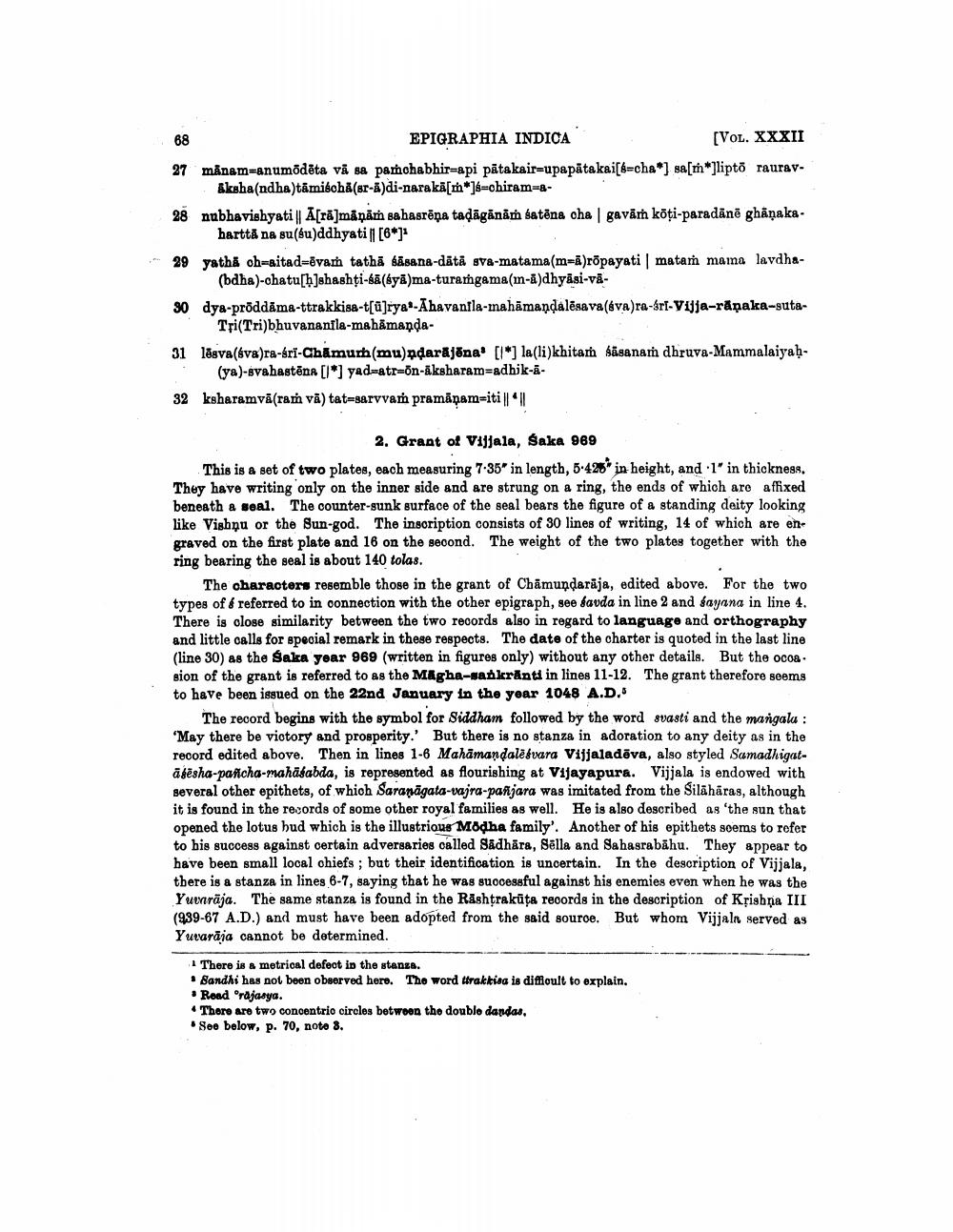________________
,
EPIGRAPHIA INDICA
[Vol. XXXII 27 månam=anumodēta vã sa pamchabhir=api pātakair=upapätakai[&-cha") sa[m*]lipto rauray
Aksha(ndha)tāmischä(sr-ā)di-narakā[*]s=ohiram=828 nubhavishyati || A[rä]māņām sahasrēņa tadāgānāṁ satēna cha | gavām köți-paradānē ghāņaka
harttă na su(bu)ddhyati (6*]* 29 yatha ch-aitad=ēvam tatha sasana-dātā gva-matama(m=)ropayati matam mama lavdha
(bdha)-chatu[h]shashți-sā(byā)ma-turamgama(in-a)dhyāsi-vā30 dya-pröddāma-ttrakkisa-t[ū]rya - Ahavanfla-unahāmandalēnava(dva)ra-Sri-Vija-ränaka-suta
Tri(Tri)bhuvananila-mahamanda31 lēsva(sva)ra-sri-Chamur(mu)pdarājēna. [l*) la(li)khitam säsanam dhruva-Mammalaiyah
(ya)-svahastēna [I*] yad-atr=on-āksharam-adhik-a32 ksharamvā(raṁ vā) tat=sarvvam pramāņam=iti || |
2. Grant of Vijjala, Saka 969 This is a set of two plates, each measuring 7-35" in length, 5.425" in height, and .l" in thickness. They have writing only on the inner side and are strung on a ring, the ends of which are affixed beneath a seal. The counter-gunk surface of the seal bears the figure of a standing deity looking like Vishņu or the Sun-god. The inscription consists of 30 lines of writing, 14 of which are engraved on the first plate and 16 on the second. The weight of the two plates together with the ring bearing the seal is about 140 tolas.
The characters resemble those in the grant of Chămundarāja, edited above. For the two types of 6 referred to in connection with the other epigraph, see lavda in line 2 and sayana in line 4. There is close similarity between the two records also in regard to language and orthography and little calls for special remark in these respects. The date of the charter is quoted in the last line (line 30) as the Saka year 969 (written in figures only) without any other details. But the occa sion of the grant is referred to as the Mägha-sankranti in lines 11-12. The grant therefore seems to have been issued on the 22nd January in the yoar 1048 A.D.
The record begins with the symbol for Siddham followed by the word svasti and the mangala : ‘May there be victory and prosperity. But there is no stanza in adoration to any deity as in the record edited above. Then in lines 1-6 Mahamandalētvara Vijjaladēva, also styled Samadhigatābēsha-pancha-mahasabda, is represented as flourishing at Vijayapura. Vijjala is endowed with several other epithets, of which Saranāgata-vajra-panjara was imitated from the Silāhāras, although it is found in the records of some other royal families as well. He is also described as the sun that opened the lotus hud which is the illustrious Modha family'. Another of his epithets soems to refer to his success against certain adversaries called Sadhāra, Sēlla and Sahasrabāhu. They appear to have been small local chiefs ; but their identification is uncertain. In the description of Vijjala, there is a stanza in lines 6-7, saying that he was successful against his enemies even when he was the Yuunraja. The same stanza is found in the Rashtrakūta records in the description of Krishna III (939-67 A.D.) and must have been adopted from the said source. But whom Vijjaln served as Yuvarāja cannot be determined.
There is a metrical defect in the stanze. • Bandhi has not been observed here. The word trakkina is diffioult to explain. • Road rajasya. • There are two concentrio circles between the doublo dandas, See below, p. 70, noto 8.




